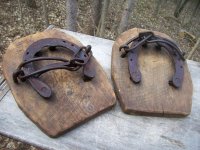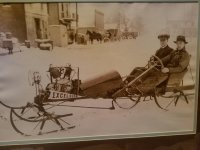This is a photo handed down from my grandparents, now deceased, who told me it was built in early 1900's by some relative. Pretty cool, thought I'd share for you old-timers. Wouldn't want to get my pant leg caught in that wheel. Hope you enjoy.
-
Enjoy XS650.com? Consider making a donation to help support the site.
XS650.com receives a small share of sales from some links on this page, but direct donations have a much greater impact on keeping this site going.
You are using an out of date browser. It may not display this or other websites correctly.
You should upgrade or use an alternative browser.
You should upgrade or use an alternative browser.
How's this for a build? Not XS Motorcycle / Snowmobile / Whatever...back in the day
- Thread starter 2XSive
- Start date
Apparently OSHA and DOT regulations weren't as strict back then....Wouldn't want to get my pant leg caught in that wheel.
Ha! That’s great! That big spiked wheel could’ve been located in a better place though! 
anyone have any idea what kind of motor that is? Old Indian maybe?Ha! That’s great! That big spiked wheel could’ve been located in a better place though!
FB71
Expert Turd Polisher
well, since the banner on the side of the machine says "Excelsior", I'm gonna guess it might be and Excelsior? 
FB71
Expert Turd Polisher
^^^ beat me a few seconds... 
Eotnak
XS650 Enthusiast
Looks more like a crotch-cooler than anything else.
High speed vasectomy installer. 
Very cool! I don't think we understand winter roads in that era. they were constantly pounded by heavy horses and freight sleds. basically ice paths.water may have been dribbled to build up the ice. I'm guessing the engine/drive wheel are on a weighted swing arm maybe even sprung to force the wheel to bear. Don't envy them trying to light off one of those gas motors in below freezing weather.
Snow removal takes a lot of effort. It was easier to switch out wheeled carriages for sleighs. Sleighs work better with more snow, so that according to this article:
in the 18th and 19th centuries, "snow was never a threat" to road travel, "but rather it was an asset."
The more densely packed snow became, the better. Some municipalities even had special "snow rollers" to compress the snow:

Indeed, ice was an asset- another example - to move the logs using horse-drawn, and later steam-powered, sleds: "There they were loaded onto sleighs and hauled over ice roads to river banks where they were stored until spring. The ice roads were also primarily a Michigan innovation. The unique roads were made by running a sprinkler over a logging road during frigid nights. By morning, the normally rutted and rough trails were turned into sheets of ice. During the day heavy sleighs loaded with logs could rapidly move over them."
Snow removal takes a lot of effort. It was easier to switch out wheeled carriages for sleighs. Sleighs work better with more snow, so that according to this article:
in the 18th and 19th centuries, "snow was never a threat" to road travel, "but rather it was an asset."
The more densely packed snow became, the better. Some municipalities even had special "snow rollers" to compress the snow:
Indeed, ice was an asset- another example - to move the logs using horse-drawn, and later steam-powered, sleds: "There they were loaded onto sleighs and hauled over ice roads to river banks where they were stored until spring. The ice roads were also primarily a Michigan innovation. The unique roads were made by running a sprinkler over a logging road during frigid nights. By morning, the normally rutted and rough trails were turned into sheets of ice. During the day heavy sleighs loaded with logs could rapidly move over them."
In my little town there was a horse-drawn trolley. Makes no sense to my understanding of the early 20th century here, which means that understanding is very wrong, no matter how nicely it fits together.
In the 60's the milk was delivered by horse and cart in Kawerau, NZ. Every morning I was awoken by the sound of their shoes on the road. Some mornings I would get up early and go ride on the cart. Basically the horses had memorised their route and would plod along while the men would run back and forth to the cart collecting full bottles and dropping off empties. Those days have gone now.
Prior to WWII Britains biggest agriculture crop was oats. Except for porridge, it all went into horse feed.
Prior to WWII Britains biggest agriculture crop was oats. Except for porridge, it all went into horse feed.
In 1943, my late Dad was 13 years old and he took an early morning job driving a milk wagon in Peterborough, ON. Each day he arrived at the Central Smith dairy at 4:15 AM, hitched up a big old draught horse named Daisy and together they went all over the central part of the (very hilly and snowy) city delivering milk.
Dad told me that all he really had to to do was jump on and off the wagon and run up to each house with the proper order while Daisy just kept toddling along without stopping. About halfway through their route, they would stop and he'd give her some oats as a treat and they would be back at the dairy by about 8:10 AM. The ladies in the dairy lunch counter would make him a big chocolate milkshake and then he'd head off to school while Daisy went back to the barn to rest for the remainder of the day.
Its sort of amazing that a big commercial dairy would entrust a little boy with a key asset and all of those customer relationships. I guess that says a lot about the availability of adult labour in those days (and, if I may, about my Dad as a young guy). After school, he went to the big Quaker Oats mill on Hunter St. in Peterborough where they made cereal and worked in the mill loading product into big sacks until around 9-10:00 PM when he finally went home to do his homework and get some sleep.
Old times - not so sure they were always good times, but they were different, that's for sure.
Pete
Dad told me that all he really had to to do was jump on and off the wagon and run up to each house with the proper order while Daisy just kept toddling along without stopping. About halfway through their route, they would stop and he'd give her some oats as a treat and they would be back at the dairy by about 8:10 AM. The ladies in the dairy lunch counter would make him a big chocolate milkshake and then he'd head off to school while Daisy went back to the barn to rest for the remainder of the day.
Its sort of amazing that a big commercial dairy would entrust a little boy with a key asset and all of those customer relationships. I guess that says a lot about the availability of adult labour in those days (and, if I may, about my Dad as a young guy). After school, he went to the big Quaker Oats mill on Hunter St. in Peterborough where they made cereal and worked in the mill loading product into big sacks until around 9-10:00 PM when he finally went home to do his homework and get some sleep.
Old times - not so sure they were always good times, but they were different, that's for sure.
Pete
That's really kind of fascinating. How do horses do on ice? I remember you all are horse people.Indeed, ice was an asset- another example - to move the logs using horse-drawn,
Do they have Winter shoes?
The horse shoes with which I am familiar have a ridge on the underside that can dig into snow or ice and so they generally do OK.
Where horses can have trouble (in my limited experience) is on very smooth concrete, particularly if it is raining - the shoe cannot dig into anything and sliding can occur.
Where horses can have trouble (in my limited experience) is on very smooth concrete, particularly if it is raining - the shoe cannot dig into anything and sliding can occur.
Normal shoes were just flat on the bottom but there are many variations of traction devices available now.That's really kind of fascinating. How do horses do on ice? I remember you all are horse people.
An antique traction shoe.
I'm sure there were as many variations of traction as there were farriers.
I've seen "swamp shoes" at local swap meets.

Cobble and paving stones are very slippery when wet or covered with horse pucky so horse shoe traction isn't just a winter thing.
My mount slipped and fell on a freshly sealcoated driveway. He went all the way down. I ended up standing, straddling him, when he scrambled back to his feet I just dropped back in the saddle and off we went. This was unusual, I normally just end up in a heap on the ground when I fall off (frequent)
Horses rightfully fear getting mired in deep mud, they can go frantic when they start sinking.
Our horses are now left barefoot since they don't get worked as long or hard as "draft horses". In most conditions barefoot has better traction than shoes, which were used mainly to avoid wearing out the horses hooves in hard use on rough ground or pavement. Now rubber boots can be strapped on for rough trail riding.

Similar threads
- Replies
- 19
- Views
- 2K
- Replies
- 785
- Views
- 81K

